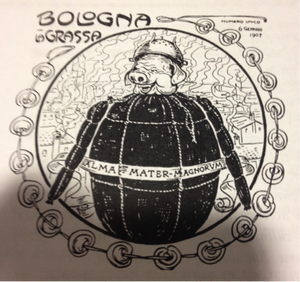Point of Origin
The hot spot for the tortellini is in the Emilia-Bologna region of Italy, more specially Bologna. This is the area with the most tortellini diversity and pride. “Tortellini are more strongly identified with Bologna than with any other place in the country; they became a badge of the city in the eighteenth century.” (Dickie, 301) The citizens of Bologna have a special attachment to the tortellini. “‘Tortellini is more essential than sun for a Saturday and love for a woman,’ said an anonymous article in the Gazzetta di Bologna of December 27, 1874. ‘The origin of the tortellini is lost in the mists of time,’ the article continues. But there are local legends. In 1925, a Bolognese named Ostilio Lucarini wrote a play called The Inventor of Tortellini.” (Root, 86) There are various legends of the tortellini that all revolve around Bologna and the surrounding region. One Bolognese legend says that when the gods walked the Earth, Venus and Zeus stayed the night at an inn near Bologna. The innkeeper was so enchanted with Venus that he looked into her bed. Shocked by her beauty, he went to his kitchen and made a tribute to her. He had made the tortellini to represent Venus’s navel. In fact, even today in Bologna the tortellini’s nickname is “sacred navel.” (Kasper, 74) Another legend that is more tied to history states that it was invented in Castelfranco Emilia and was inspired by the navel of Lucrezia Borgia the beautiful illegitimate daughter of Pope Alexander VI, Rodrigo Borgia. An innkeeper became enchanted with her. He peered through her door and saw her navel. The image inspired him to create the dumpling after the shape of her navel. The final legend is that the tortellini is molded after the turtle, particularly in a variation of tortellini that has a very small opening. The turtle was a popular architectural motif of the eighteenth century in Emilia-Bologna region. (angsarap.net)
Photo (Top): The CIty of Bologna. <http://cdni.condenast.co.uk/646x430/a_c/bologna_cnt_9nov09_istock_b_1.jpg>
Photo (Bottom): Kasper, Lynne Rossetto. The Splendid Table. New York: William Morrow and Co., 1992. 74.


